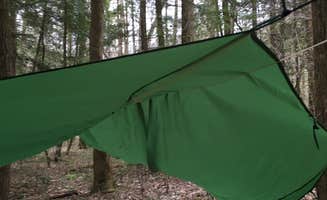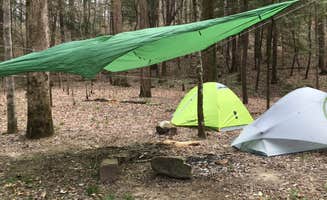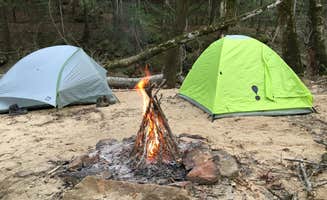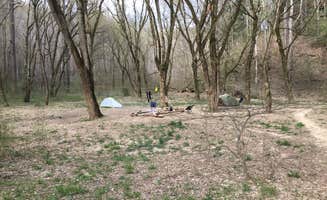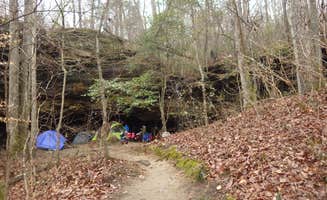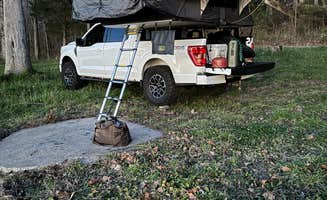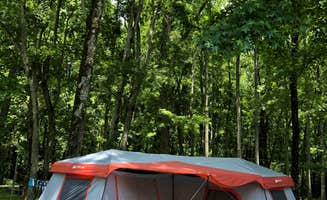The Sipsey Wilderness area provides numerous tent campsites near Midway, Alabama within Bankhead National Forest. This region features an intricate network of sandstone canyons formed over thousands of years by water erosion, with elevations ranging from 500-1,000 feet. Seasonal rainfall dramatically impacts trail conditions, with spring typically bringing 4-6 inches of monthly precipitation that creates vigorous waterfall displays.
What to do
Waterfall hunting: Several trails in Sipsey Wilderness lead to waterfalls of varying heights. The hike on Trail 206 offers access to Thompson Creek's clear turquoise waters. "The water is a beautiful turquoise. Most of the campsites have giant moss covered boulders all around, and cliffs in the background opposite the river," notes Aaron S. from Thompson Creek Trail Campsites.
Creek exploration: Wade through the shallow sections of creeks that intersect throughout the wilderness. "The trail follows Thompson's Creek, it is next to all of the campsites. Water levels tend to be higher during the winter," reports Aaron S., who also mentions, "Most of the time, except during dry spells, there are LOTS of waterfalls. Also lots of shallow places for the kids to play in the water."
Night sky viewing: The limited light pollution provides excellent stargazing opportunities away from the trailheads. At Sipsey Wilderness Backcountry Site (Trail 200 Site H), Asher K. recommends, "This site, in particular, is one of my favorites to stay at. It has several waterfalls nearby, is close enough to the river for easy water access, and is secluded from many other sites."
What campers like
Privacy between sites: Many campsites offer natural separation despite proximity to trails. "This site has space for around 2 tents though you could possibly squeeze in a 3rd and it has a nice sized firepit with a large dead log that was perfect for sitting on," shares Asher K. about Sipsey Wilderness - Trail 200 Campsites.
Sandy tent sites: Several campsites feature sandy soil that provides comfortable tent placement. "Most of the site is pretty sandy but level which was wonderful for sleeping on," notes Asher K. about Trail 200 campsites, adding, "If you want an easy access site to a parking area either because you are getting a late start to a backpacking trip or you want to camp near your exit point on your last night this is a wonderful spot."
Group camping options: Larger groups can find accommodating sites along certain trails. At Sipsey Wilderness Backcountry Site (Trail 200 Site G), Asher K. describes, "This site is by far the best site if you have a group of 3 or more tents. It has several firepits and is spread out over a large area. Each individual site has enough privacy while still providing group areas to congregate."
What you should know
Variable water levels: Creek crossings can be challenging depending on seasonal water levels. Miranda C. from Thompson Creek Trail Campsites reports, "You do have to cross a stream, which was not as difficult for my 6'2 husband as it was for me at 5'2."
Limited services: All wilderness campsites lack facilities, requiring self-sufficiency. "The entire Sipsey Wilderness is gorgeous, but if you want a trail with lots of great spots to camp, this trail is fantastic. Don't expect bathrooms or drinking water to be nearby," advises Trinity W.
Trail conditions: Many trails aren't maintained to high standards. At McDougle Hunt Camp, Asher K. notes, "This is another basic campground in the Sipsey wilderness area. The amenities are very limited but it gives you easy access to lots of amazing hiking in the area."
Tips for camping with families
Kid-friendly water areas: Seek out shallow creek sections for safe water play. Trinity W. shares about Thompson Creek Trail, "Also lots of shallow places for the kids to play in the water. Watch for snakes and bring bug spray."
Manageable hike distances: Some sites require minimal hiking, suitable for young children. Jimmy R. reports, "Me and my 6 year old daughter hiked the trail this past Saturday, July 27, 2019. Had a great time. Definitely be back."
Wildlife awareness: Teach children about local wildlife safety. At Sipsey Wilderness Backcountry Site (Trail 207 Site C), campers often encounter small wildlife along creek beds, so prepare children for these encounters and establish clear boundaries around water.
Tips from RVers
Limited RV options: Most Sipsey Wilderness campsites aren't suitable for RVs, but some trailhead access points accommodate smaller units. Dani K. from Thompson Creek Trail Campsites shares, "The roads aren't the best but my van made it despite the muddy potholes."
Day-use alternatives: RVers can park at designated areas and hike to tent sites. "Trailhead is down from the campsites a ways, probably would drive it not walk it," mentions Dani K., indicating some separation between vehicle access and actual camping areas.
Access road considerations: Forest roads leading to trailheads vary in condition. Terrell B. reminds campers to "Leave no trace" when visiting these primitive campsites, as maintaining the natural environment becomes more challenging when vehicles venture into less developed areas.



